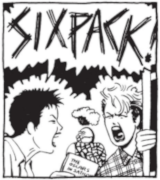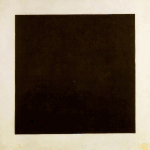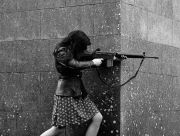|
Btw are people okay with the way I'm analysing the rules? Any suggestions? People that are familiar with the games already: any mistakes?
|
|
|
|

|
| # ? Jun 3, 2024 10:05 |
|
Tekopo posted:Btw are people okay with the way I'm analysing the rules? Any suggestions? People that are familiar with the games already: any mistakes? I'm good with it.
|
|
|
|
Oh I missed an interesting rule: for some hexes (like for example, cities), entering the hex doesnít mean you immediately capture it, but have to perform a clearing operation, which has the potential for making you lose steps. Itís an interesting take on having to clear enemy troops from a city and the low level fighting that can occur after a city is captured.
|
|
|
|
Tekopo posted:Btw are people okay with the way I'm analysing the rules? Any suggestions? People that are familiar with the games already: any mistakes? enjoying it! edit: this chat made me pull out Taiwan and its made me realise the naval map is out of date! China now is way more dominant over the Spratlys, Ryuoko and South China Sea than in 2014. wonder if theres updated setups to reflect this, it would affect play quite a bit Sleekly fucked around with this message at 02:02 on Mar 12, 2021 |
|
|
|
Panzeh posted:Next War's air system kind of resembles a sane person's take on GDW's Fulda Gap games and it's no surprise that Chadwick and Emrich use it for their big ww2 games, too. Which ones? Is this thunder in the east?
|
|
|
|
Tekopo posted:Btw are people okay with the way I'm analysing the rules? Any suggestions? People that are familiar with the games already: any mistakes? I'm not familiar with the games, but this seems pretty clear to me.
|
|
|
|
tomdidiot posted:Which ones? Is this thunder in the east? Yeah, that and the Middle Sea.
|
|
|
|
Panzeh posted:Yeah, that and the Middle Sea. Makes me want to reconsider selling it now. I haven't got a lot of interest in hypothetical wargames, but i've heard so mayn good things about next war's air system.
|
|
|
|
the hypothetical side does feel weird but not quite on the Ty Bomba level. i got so sick of ww2 and the same units on the same battlefields and i like these because they try to reflect modern capabilities. i cant tell you guys how jarring it felt in NW Poland to be marching a heap of Germans in there...as the 'good' guys i do find one of its optional rules distasteful. there is a refugees rule where the major roads are so clogged with refugees theres a movement penalty...for shooting or running over refugees? maybe u just are carefully driving around them? and they're all so dumb they ignore the numerous other paths they could take that dont have armoured columns on them all the time? it just feels icky
|
|
|
|
I mean, one of the reasons why I decided to buy NW: Vietnam was because the thought of Vietnamese and American forces fighting together was weird and interesting.
|
|
|
|
Sleekly posted:i do find one of its optional rules distasteful. there is a refugees rule where the major roads are so clogged with refugees theres a movement penalty...for shooting or running over refugees? maybe u just are carefully driving around them? This has been a real thing throughout history - it was a big problem iirc for the French and British at the beginning of WWI due to the sheer numbers of Belgian and French people fleeing from the German advance and clogging up the roads. I think it's supposed to represent a generic traffic jam (I don't know if Next War represents this in the way say BCS does) rather than running over refugees in an Abrams.
|
|
|
|
Sleekly posted:the hypothetical side does feel weird but not quite on the Ty Bomba level. As has been said above, roads clogged with refugees are a thing in wartime, particularly in a general collapse situation. This generates giant traffic jams, because yes, you need to go around them or get them off the road (peacefully - I can't really think of situations where tanks would just run over people, but if they are in a horse cart or a broken-down car, that will take effort to remove from the road). You can see this a lot in very early and very late World War II - columns of refugees fleeing bombed-out cities in Poland contributed to slowing down the Polish retreat and many large units being chased down or encircled by the Germans a lot easier, and then the same happened with Germans fleeing East Prussia ahead of the Soviet advance. As to why they ignore the numerous other paths - there often are no other paths, and the refugees are operating in conditions of limited information. They don't know where your armour is going or where from, and they probably don't care all that much, what they want is to get out of the warzone. Why wouldn't they take the main road? Why should they risk the front line catching up to them?
|
|
|
|
these posts make sense. i guess the rule is doing its job, making me think about this stuff.
|
|
|
|
Next War: Vietnam Part Duex Advanced Rules In the last post, my final thought of the Standard Game was that it seemed lacklustre: I've always had the mind that trying to microscope down to the nitty-gritty details can cause less fidelity in terms of historicity than a properly constructed abstraction, but I think the Standard Game went too far, and seemingly misses out the fact that high-tech platforms can have a significant impact in modern war. As such, I will explain first of all what is probably the biggest change between the Standard and Advanced game, which is the air war. The air war, as mentioned in comments by other goons, is a little mini-game of its own. Instead of purely contrasting the air point differential in order to see if one side or the other has air-superiority, the fight itself is played out using actual units, that they themselves can be damage or removed from the game as the conflict progresses. An air units has various different ratings, foremost of which are Anti-Air (including either stand-off or long range capability, as marked with asterisks), Close Support (CAS) or Strike (with an asterisk marking stand-off strike capability). Also present are range (this is not demarked in hexes, but simply a letter, denoting unlimited, long, short etc: this is only relevant in terms of the ranges of basing boxes, with certain basing boxes being too far from the action for shorter-range aircraft), as well as pilot ability, with the same type of aircraft potentially having counters with varying pilot skill. Finally, the airplane can be an all-weather plane (in which case they are more effective even during adverse weather) or a stealth plane (in which case it is not possible to engage them in long-range or stand-off combat, although they can still strike back). Basing boxes are where aircraft are stationed, and are attached to specific areas either on the strategic or tactical map. Each basing box is made of several different sections, which represent the combat readiness of the aircraft itself: a plane can either in the Aborted, Flown or Ready box, with aircraft being placed in specific boxes depending on combat results, and then moving down towards ready in future turns (it is possible to move from Aborted immediately to Ready, if a die-roll is made). Aircraft in the Ready box can, during the Air/Naval phase, be selected for the air superiority mission, as long as they have air-to-air capabilities. Once both sides have selected which units are to be included, the units are paired off, with the side that has AWACS Advantage (a simple track that shifts depending on the results of the air supremacy combat), getting to choose first, alternating until all of the aircraft have been paired off. If any units are left over after this, they get to gang up on a pairing, although the odds in number of units can never be more than 2:1. Combat now occurs, with long range combat occuring first: this, of course, can only be conducted by units which have that capability. Combat for this phase is simultaneous, and both sides roll: the way you determine the column is by calculating the differential between the attacker and defender Anti-Air value, and then various DRMs (including pilot skill) are applied, with lower results producing better outcomes. The outcomes can be forcing the enemy unit to abort, or damaging them, or killing them outright, or potentially just gaining the advantage in subsequent turns of combat. Once the effects of long-range combat have been finished, the game proceeds to stand-off combat. It is relevant to note here that a unit that has beaten off its opponent is not allowed to re-engage other enemies during air superiority combat, so once an enemy is destroyed or forced to abort, that's it for the unit. Stand-off combat is similar to long-range, but includes units with only stand-off anti-air ratings (naturally), and yet again the combat is simultaneous , apart from units that gained an advantage in the previous round. Finally, we get to Dogfighting, where everyone can join in. However, during this phase, combat is not simultaneous and instead, is based on the Anti-Air rating of the unit, with better units being able to strike first, which makes sense in terms of how dogfighting could be abstracted within the game. Once this phase is over, any surviving units from both sides remain within the Air Superiority box, and the ratio between the sides, in terms of pure units remaining, is used to determine which sides has air superiority/advantage (which increases you AWACS advantage by one), or even air supremacy (by two). So far so good, but what does having air superiority actually do? Apart from AWACS advantage, it helps you detect enemies using air reconnaisance, but I will dwell on that later, when we get to the section about detection. The main thing, though, is that any units you have remaining can be selected to be escorts for strike or combat support missions. Combat support is very similar to the one for the Standard Game, but Strike is where a whole new system has been added in. Basically, Strikes, either from aircraft, choppers or artillery units/HQs allow you to reduce the capabilities of your opponents units or installation. When you conduct a strike, you place Strike markers (either 1 or 2, depending on the severity), and these reduce the capabilities of the unit or the installation. For example, placing strikes on airfield/airbases forces aircraft to be sent to the Flown box before they even get to be chosen for Air Superiority or any other kind of mission, as well as potentially causing step losses as well. The same strike markers on a ground unit reduce its ER, offensive and defensive rating, in a similar way that DisOrg markers in OCS reduce combat abilities. This, I feel, gives a more nuanced view of the effect of airstrikes, and how they can be used outside of simply providing combat support to an offensive. Before they can Strike, however, an air unit has to get through the ADF gauntlet. Each side has tracks detailing their detection, SAM and AAA capabilities, although these are defined as their "Normal ADF". There is also "Local ADF" which is weaker, and there are a bunch of rules detailing which of the two is used, although usually they are to the effect that strikes within your opponent's country use Normal ADF, and strikes outside of that (for example, attacking enemy units that are invading your country), use Local instead. First, you roll to see if the Aircraft Packet (which can be up to 4 units) is detected. The results can be either Early Detection (which allows your opponent to send his air units to intercept your mission, as well as the use of SAM), Detection (which only allows SAM) or no detection. AAA always fires regardless (unless the Strike is a stand-off strike), but detection determines if the AAA fires before or after the strike has happened. Interception is similar to the air combat for Air Superiority, with the notable exception that escorts have to be engaged first, and that attackers are allowed to re-engage other units once they have driven the escorts away. SAM and AAA ADF has a variety of results, including damaging, aborting or causing the enemy aircraft to have a DRM against its Strike/Support Mission, which represents the ADF causing it to be harder for the aircraft to perform its strike/support mission. Helicopters work in similar way, although they are more limited in the ways that they can operate. The air combat adds a lot to the game, in my opinion, but does make the entire thing quite a lengthy endevour. After all, there are a lot of dice rolls involved in trying to figure out who wins in the air, but I think the extra granularity does add to the game and the mechanisms themselves add to the fun, especially since they make it more interesting to represent the degrading capabilities of either side. Another major system, and one that I'm actually quite fond of, is Detection. Detection means that your units know the precise location of an enemy unit, which thus allows you to strike it with aircraft and other means. The only units that automatically detected are ones next to your own units, but there are other methods of detection. For example, if you have air superiority/supremacy, you are able to detect specific enemy units a certain number of hexes away from your bases, and thus make it far easier for you to strike at them. Otherwise, it is possible to detect units through electronic means (this is usually reserved for HQs), although you only have a limited number of such attempts per turn. Detection is conducted by rolling on a table with the relevant column and DRMs, and seeing if the detection occurs or not. Another way of detection is through the use of Special Operations Forces. SOF are basically your elite units that operate behind enemy lines and one of their potential missions is detecting enemy units. The success of the mission depends largely on the target and the hex that the target occupies. Another mission is targeting, which is basically laser-designation of targets to make it easier for other assets to strike them. They can also raid enemy units (with success dependant on the enemy unit/terrain), which can place Strike markers or cause a step loss. The targets can be enemy units, supply units, HQs, or even tracks like the Detection/SAM track (this is also true for any other type of strike). The supply system within the game forces you to daisy chain back to a supply source. Units need to trace a number of MPs to a HQ, which itself has to trace back to a supply source, supply depot or MSU (mobile supply unit, which itself has to be able to trace back to a supply source/depot). Supply Depots and MSUs can be constructed during a turn, and this is done by the use of supply points, which allow you to create an MSU or turn an MSU into a supply depot. Units that are OOS have to half their combat values and reduce their ER, but potentially units can also be Isolated (if they are surrounded by enemy units), which means that they receive further penalties. Supply points, however, can be directly spent to prevent a unit from going out of supply, although since they are usually pretty scarce, it's not advisable to do use. Supply points are also used to potentially replenish units, aircrafts, or repairing installations so using them or not can be a tricky puzzle. The Advanced Game also features the inclusion of HQs and Artillery units. HQs, along with providing supply to the units within their formation, can also be used to conduct strikes as well as providing a better ADF umbrella to units near them. Artillery can also be used to conduct a strike in a similar way. HQs also can directly support both attacking and defending ground units at a set range, similar to the way that Totaler Krieg handles it, although they are limited in terms of the number of such supports that they can grant. The support means that you can add the strength of the HQ to your attack or defense. HQs can also build bridges accross rivers using their engineering equipment. Another potential way to perform strikes is through the use of Theather Weapons, which are basically things like cruise missiles, SCUDs or other long-range weapons. The final adjustment for the Advanced rules is in terms of naval units. Air-strike against naval units use a similar Detection/SAM/AAA method as standard ADF,, and it is now possible to perform surface combat between naval units, although in order to strike at enemy units it is necessary to detect them first. There are two detection levels: area (ie, you know the general area where the enemy is) or point (ie you know exactly where they are). It is possible to conduct strikes against naval units that are area-detected, but there are penalties in doing so. Naval combat can occur, with non-detected naval units firing first, but they themselves becoming detected as soon as they engage). Naval combat is conducted like a number of consecutive strikes against the opposing targets. Finally, one rule alteration is that Light Infantry units can infiltrate through enemy-occupied hexes: they roll an ER check and can pass through the enemy hex if they succeed, or receive a number of strike markers if they fail. Overall, the advanced game does add a lot of extra difficulty to the game, but I think it's warranted in terms of what the game itself is attempting to portray. It's a lot of extra, nitty-gritty detail, but modern war is quite reliant on the specific platforms that the Advanced Rules attempt to abstract, and I think it does the conflict more service than the extremely abstracted rules presented in the Standard Game. Overall, I'd be interested in trying out the Advanced Game immediately, while the Standard one does not have much appeal apart from a tutorial. Next up, Game Specific Rules!
|
|
|
|
Picked up a copy of Brief Border Wars by Brian Train. Seems interesting just checking it out. 4 conflicts: Sino-Vietnamese War 1979, Football War 1969, Operation Attila 1974, and South Lebanon 2006.
|
|
|
|
Another interesting thing that SOF, Strike aircraft, and I think attack helicopters can do is interdiction. You target a hex (with limitations for targetable terrain for SOF) and roll on the interdiction table. Success denies usage of roads and imposes an additional 1 or 2 MP to move into the hex. Seems like it could be really useful for cutting enemy supply lines or stalling reinforcements.
|
|
|
|
SavageMessiah posted:Another interesting thing that SOF, Strike aircraft, and I think attack helicopters can do is interdiction. You target a hex (with limitations for targetable terrain for SOF) and roll on the interdiction table. Success denies usage of roads and imposes an additional 1 or 2 MP to move into the hex. Seems like it could be really useful for cutting enemy supply lines or stalling reinforcements.
|
|
|
|
Tekopo posted:Yeah, you can do something similar in OCS, which is why I really think there was a lot of inspiration taken from that to come up with the NW system. The funny thing is it's often not worth doing in OCS because shooting up the front line is often a better bet. Except in Korea, but that's becasue you get super interdiction as the allies.
|
|
|
|
Tekopo posted:The targets can be enemy units, supply units, HQs, or even tracks like the Detection/SAM track (this is also true for any other type of strike). just wanted to highlight this, its really vital that you do this as much as feasible. if you already have air supremacy then grind your boot. or talon. if you dont then try to poke holes in theirs. in a game where your options can be overwhelming simply moving any of those tracks in your favour is always a solid option whether you have the initiative or not
|
|
|
|
tomdidiot posted:The funny thing is it's often not worth doing in OCS because shooting up the front line is often a better bet. Except in Korea, but that's becasue you get super interdiction as the allies.
|
|
|
|
A reprint of Maria just appeared. How is it? It looks like a very simplified version of Here I Stand.
|
|
|
|
Nothing like HiS, three player only, good but VERY fragile so the first game or two will likely end in a very anticlimatic way.
|
|
|
|
Terminally Bored posted:A reprint of Maria just appeared. How is it? It looks like a very simplified version of Here I Stand. Yeah, there are absolutely zero similarities between HIS and Maria. Except maybe location movement.
|
|
|
|
Maria is very good and teaches you that sometimes to win in a wargame, you have to lose.
|
|
|
|
That is funny, because my understanding of the moral of Wargames is that the only way to win is not to play.
|
|
|
|
Ilor posted:That is funny, because my understanding of the moral of Wargames is that the only way to win is not to play.
|
|
|
|
Tekopo posted:I've used interdiction to good use in Tunisia II, or any situation in which you know where the enemy mobile troops are coming from. I guess. I think I always found it more useful to use my air forces to guarantee the breakthrough than to stop a reaction force, but I can see how they'd be useful for smothering reaction stacks.
|
|
|
|
Next War: Vietnam III: Next Warer Game Specific Rules Game Specific Rules (GSRs) are mostly modifications to the existing rules along with specifications on particular units that are available to each sides, as well as specifying what kind of escalation levels are available for both sides. Escalation within Next War: Vietnam is relatively limited: the allied player (ie, Vietnam, in this game) has the choice of getting help from US, Commonwealth or French troops, although it is clear that the former is the one that makes the most sense in terms of the potential conflict, as well as the fact that the US has a lot more toys than the other two potential allies. The game also features potential allies that don't side with one side or the other at the start of the conflict, but are randomly determined to be either on one side or the other when a specific trigger is met. The countries potentially in play are the Phillippines, Malaysia, Indonesia and Thailand. The inclusion of these extra sides only happens within the Advanced game, however. The GSR section about special units is rather sparse: there are some limitations on airmobile units for People's Republic of China (PRC) airborne mechanised brigades, and specification that PRC amphibious units can perform amphibious assaults. The main item of interest, is the Socialist Republic of Vietnam (SRV) People's Self Defence Forces, which are basically a citizen militia that has 0 movement and 0 attack, and therefore can only be used to garrison specific spaces. The interesting thing about them is that they can appear on the board either as garrisons or resistance markers, and can turn from garrison to resistance markers if they lose combat (although an ER check is required). Resistance markers make it more difficult for the PRC to run Clearing Operations, which models local resistance units within cities/etc. At the start of the game, the PRC player has a choice to either attack in the Dry or Wet season, which affects the DRMs for weather determination. Although initially the PRC has local air superiority over the SRV, the manual notes that the PRC might want to attack during the Wet season in order to minimise the effect of the much larger US air-force. The next section of the rules are mostly about how movement is affected and how to use the strategic display for movement around the sea boxes and locations such as the Spratley Islands. I'm not going to go into too much detail here since none of it is particualrly interesting apart from proving rules for how to use those particular boxes. There are also sections for where reinforcements appear in specific situations, how multi-nationality stacks operate, how islation and supply works, and rules that dictate how airpower operates in the standard and advanced game. In terms of interesting stuff, China has the use of S-300 SAMs: the effect of them is that they extend the "friendly country" envelope for local and normal ADFs to the entirety of the Operational Map. Strangely, the printed counters also have stats on them, but I am not sure what exactly the stats do: I think they are used as part of optional rules that model the S-300 more accurately, and some searching reveals that the rules for them are present in Supplement 1 for Next War. This is kind of annoying because, as far as I can see, the GSR don't actually tell you that you can ignore these values. Next up, rules for theatre weapons: cruise missiles for both sides, Brahmos cruise missile batteries for the Philippines and SCUDs/other ballistic missiles. The most interesting though, is Tactical Nuclear Weapons. The PRC has always access to them and can use them as they will, while the Americans can only release them if the PRC has used them first, or if the PRC can potentially win an automatic victory. Once placed, you roll a dice to determine if the tactical weapon is full yield or not: only a roll of 9 is a potential malfunction, and even then you need to roll odd on a following dice for it to actually malfunction. If the attack is full yield, all units in that hex lose a step, and, if it surives, receives 2 strikes. All installations are destroyed as well, as well as any bridges. The hex is permanently marked as having received a nuclear attack, which affects the ER of any unit within the hex or any surrounding hex, affects movement through the hex (and destroys any roads present). The negatives of using nuclear attacks is that you award VPs to your opponent for just using them, and potentially cause Global Thermonuclear War, which is a roll with modifier to see if the game ends immediately, with the chance being dependent on how many nuclear attacks have been made (although even just a single attack has a 20% chance of causing GTW). Finally, we get to the optional rules. These are mostly things like "do you want to have more F-35s, or more F-22s., or giving the PRC access to J-31 stealth fighters. Each of these options affect the VP total for both sides. There is also rules for both Commonwealth and French intervention, as well as rules for Chemical Weapons , Refugees and variations for Diplomacy and how to handle Storms. The GSR then has the standard and advanced scenarios, which I will list below: Standard Scenarios: - Deja Phu: A training scenario where the PLA paradrops into Dien Bien Phu and are surrounded: this, as per the rules, is just meant to allow the players to try out the intricacies of the combat system. - Third Indochina War, Redux: The attack of the PLA from the Northeast, like they did historically in 1979. - Eastward, Ho!: The attack of the PLA from the Northwest. - The Gates of Hanoi: This is the main standard game campaign, and is basically just meant to be the main way to play the game if you are just using standard rules. The Advanced scenarios include rules for selecting the level of US intervention (which is set in stone for the Standard game), so potentially you can get no US intervention, just supplies/training, just air/naval support, or even boots on the ground (with two different levels of boots on the ground support, either just marines/airborne or full intervention). The PRC can also decide if they want to extend the conflict to inciting the North Koreans to attack at the same time, which automatically sets the intervention level to maximum for the US, but forces some US units to go to Korea instead based on a dice roll (this potentially can be a reason why the SRV player might not want to immediately set the intervention level to 4, since then extending the war to North Korea is essentially free for the PRC). There are also the rules for how the get the other 4 minor sides (indonesia, Malaysia, Philippines and Thailand. The checks are made when the PRC enters either the Spratleys or the Paracels islands, and for Malaysia and Indonesia, it is a straight roll, with both sides either joining the PRC side, the SRV side, or remains neutral. Indonesia is less likely to join, and has more chance of joining the SRV side, Malaysia is overall more likely to join the conflict, but still with an advantage to the SRV side. Philippines are handled somewhat differently, since you use the current US intervention as a DRM, making it more likely that the Philippines join the SRV side if US intervention is high. As well as that, if they join the PRC, their units are of lower quality, representing general unwillingness to fight for the PRC. Thailand is also handled differently. If US intervention is at level 3 or 4, they can pressure Thailand to let them use their airbases, although this costs VPs. A diceroll is needed to see if the pressuring works, although additional VPs can be spent to affect the dice roll. When a roll is made to see if Thailand joins the war, if the US pressured successfully, there is no opportunity for Thailand to join the PRC, otherwise Thailand has a slightly better chance of joining the SRV over the PRC. Finally, we have rules for automatic increase of the intervention level, which occurs when certain US bases are attacked, or if CVs are eliminated. Advanced Scenarios: - Strategic Surprise: This is a campaign scenario where the outburst of war is sudden, and therefore neither side has had a decent chance to prepare for the conflict. - Tactical Surprise: This is a campaign scenario where the tension has been building gradually, and the PRC finally attacks at an unexpected time. - Extended Buildup: This is a campaign scenario where both sides have had a long time to prepare for the conflict. And that's pretty much it. There are also rules for combining NWV with NW: Taiwan and NW: North Korea, along with the usual designer notes. Overall, not much to say beyond what I've stated already for the standard/advanced rules. Next up, I am going to go through the Deja Phu scenario to showcase the combat system of the game!
|
|
|
|
My copy of GMT's Atlantic Chase arrived today ! Bad news: a page of errata attached to the sealed box. Good news: the box is extra thick and appears to be completely full. Good news: It is ! Rules, 64 pages. Tutorial, 56 pages. Advanced battle rules, 16 pages Solitaire scenarios, 72 pages, 15 scenarios Two player scenarios, 64 pages, 9 operational scenarios, 12 mini-scenarios, and a campaign game in 5 Operations from 1939 to 1942. Every book is lavishly illustrated with color diagrams. The 10 tutorial scenarios are presented as extended Examples of Play. Next up, 2 11x17 (folded) player aid charts, and advanced battle chart of the same size, force pool schedules for both sides (1 page ea), and a task force display card for each. Finally a double-side inset map to show the North Sea, and the Norwegian Sea. Then we get 1.5 sheets of double side counters, a mounted folding map covering the North Atlantic and the Battle Boards. At the very bottom of the box we have some cardboard to make the above sit comfortably over 4d6 (2 red, 2 blue) and a bag full of wooden Station and Trajectory markers. What are those markers you ask ? A task force can be either in a fixed location, a "Station[ary] force, on a route from once place to another - its trajectory. A force could be anywhere along its trajectory. Enemy force with try and intersect a Trajectory with Recon and Intel. Once a TF is localized, you can attack it. Goddamn but there's a lot of stuff in this box.
|
|
|
|
mllaneza posted:My copy of GMT's Atlantic Chase arrived today ! Reminds of Operation Dauntless - that game has a small library in the box too 
|
|
|
|
I watched the videos for Atlantic Chase and decided to buy it in the end: innovative new systems are my jam, and it looked like it was trying to do things differently from the norm, which was welcome. Also I'm a sucker for game systems that try to simulate wargames by duplicating maps and charts used at the time.
|
|
|
|
SavageMessiah posted:Reminds of Operation Dauntless - that game has a small library in the box too For the price it looks like an absolute steal.
|
|
|
|
I didn't P500 Atlantic Chase but decided to preorder it from retail because its bonus time and dammit I deserve nice things. Now to make my way through the videos while I juice myself up with excitement.
|
|
|
|
Lamps 2nd ed is going out. I got mine yesterday. The quality of everything is quite good, with mounted maps, thicc rounded counters, and improvement in the card-stock used on the manuals. Game on!
|
|
|
|
Good news on the Atlantic Chase front ! There's an official Tabletop Simulator module for it. I just ran the first two tutorial modules, and it looks like a good module. Who wants a game, next Sunday maybe or an evening PDT ? I've got a new mantra now, Play passes. Graf Spee checks weather. Graf Spee passes, do Time Lapse Play passes, tanker checks weather Tanker passes, do time lapse Play passes. Graf Spee checks weather. Graf Spee passes, do Time Lapse Play passes, tanker checks weather Tanker passes, do time lapse Play passes. Graf Spee checks weather. Graf Spee passes, do Time Lapse Play passes, tanker checks weather Tanker passes, do time lapse Play passes. Graf Spee checks weather. Graf Spee passes, do Time Lapse Play passes, tanker checks weather Tanker passes, do time lapse The trajectory thing is starting to come together. Putting them down and picking them up again is definitely helping.
|
|
|
|
Are there some Goon Opinions of Flying Pig's Armageddon War? It seems to be extremely my poo poo, but the Ticketmaster-like prices make me not want to commit if I don't love it.
|
|
|
|
I'm wondering if anyone has suggestions for an introductory wargame? I'm quite familiar with board gaming generally but not really this genre. Axis & Allies is probably my only exposure and I am attracted to the larger-scale, economic side of things more than the tactical. Fantasy, historical, doesn't matter to me. Also would like to avoid games in which one side plays from the perspective as the Nazis or other genocidal regime. Thoughts?
|
|
|
|
if you are interested in larger-scale stuff, there's a lot of Strategy-level games out there, but the historical ones tend to be centred around World War II, and by your criteria that's out of the window. If you aren't really all that bothered about going for historical stuff though and care more about the economics side of thing, there are a load of "Dudes on a map" games that might fit the bill. This thread usually focuses on historical stuff but some things that might interest you are stuff like Eclipse, or Twilight Imperium, or the Games of Throne board game. If you are looking for something more akin to hex and counter, there's also stuff like Space Empires 4X, although this tends to be a lot more difficult to play through than the things I suggested before. If you really want historical, the COIN series are not bad, although some of the sides (especially for modern COINs) in those games can be kind of hot topics in terms of the regime you are playing. There's also stuff like Virgin Queen or Here I Stand centred around the wars of the reformation, but they are quite complex beasts. Really, it depends on how complex you want the game to be, if you really need for it to be historical, and if you are looking for a more traditional hex'n'counter experience or are fine with playing DOAMs.
|
|
|
|
Quiz posted:I'm wondering if anyone has suggestions for an introductory wargame? I'm quite familiar with board gaming generally but not really this genre. Axis & Allies is probably my only exposure and I am attracted to the larger-scale, economic side of things more than the tactical. Fantasy, historical, doesn't matter to me. Also would like to avoid games in which one side plays from the perspective as the Nazis or other genocidal regime. I would definitely recommend Quartermaster General 1914 as long as playing as the powers in WWI wouldn't be too genocidal for you. Maybe something like 1944: Race to the Rhine would also float your boat (the players are all Allied commanders, the system handles the Nazis). Conquest of Paradise has several good reviews and seems to play to your interests, but I think it is out of stock most places. Twilight Struggle/Imperial Struggle again depending on how you feel about playing the countries in those games. All of those recommendations are not "traditional" hex and counter games because I think H&C games tend to involve more tactical play, and because it's harder to think of recommendations in that field that have economic aspects and aren't about WWII.
|
|
|
|

|
| # ? Jun 3, 2024 10:05 |
|
Tekopo posted:if you are interested in larger-scale stuff, there's a lot of Strategy-level games out there, but the historical ones tend to be centred around World War II, and by your criteria that's out of the window. If you aren't really all that bothered about going for historical stuff though and care more about the economics side of thing, there are a load of "Dudes on a map" games that might fit the bill. This thread usually focuses on historical stuff but some things that might interest you are stuff like Eclipse, or Twilight Imperium, or the Games of Throne board game. If you are looking for something more akin to hex and counter, there's also stuff like Space Empires 4X, although this tends to be a lot more difficult to play through than the things I suggested before. blackmongoose posted:I would definitely recommend Quartermaster General 1914 as long as playing as the powers in WWI wouldn't be too genocidal for you. Maybe something like 1944: Race to the Rhine would also float your boat (the players are all Allied commanders, the system handles the Nazis). Conquest of Paradise has several good reviews and seems to play to your interests, but I think it is out of stock most places. Twilight Struggle/Imperial Struggle again depending on how you feel about playing the countries in those games. Virgin Queen and Here I Stand look really interesting to me, but I'm a little concerned about the heaviness/length for my group. Similarly, I love what I read about TI but probably too heavy for the folks I could convince to play. Are there any quality titles in the vein of those three that are slightly more accessible? I had my eye on Conquest of Paradise as well. Does anyone have experience with that? Or Sekigahara? Thank you guys for the suggestions!
|
|
|





























